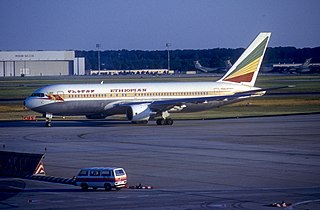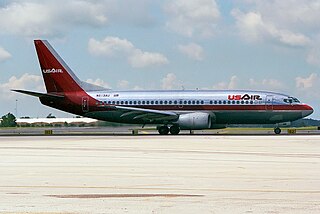
An aviation accident is an event during aircraft operation that causes serious injury, death, or destruction; an aviation incident is any operating event that compromises safety but does not progress to an actual accident. Preventing accidents and incidents is the main goal of aviation safety.

Ethiopian Airlines Flight 961 was a scheduled international flight serving the route Addis Ababa–Nairobi–Brazzaville–Lagos–Abidjan. On 23 November 1996, the aircraft serving the flight, a Boeing 767-200ER, was hijacked en route from Addis Ababa to Nairobi by three Ethiopians seeking asylum in Australia. The plane crash-landed in the Indian Ocean near Grande Comore, Comoros Islands, due to fuel exhaustion; 125 of the 175 passengers and crew on board, including the three hijackers, died. This is the first recorded instance of a partially successful ditching utilizing a wide-body aircraft.

UTA Flight 141 was a scheduled international passenger flight operated by Guinean regional airline Union des Transports Africains de Guinée, flying from Conakry to Dubai with stopovers in Benin, Libya and Lebanon. On 25 December 2003, the Boeing 727–223 operating the flight struck a building and crashed into the Bight of Benin while rolling for take off from Cotonou, killing 141 people. The crash of Flight 141 was the deadliest crash in Benin's aviation history.
This is a list of aviation-related events from 1970.
This is a list of aviation-related events from 1977.
PT Lion Mentari Airlines, operating as Lion Air, is an Indonesian low-cost airline based in Jakarta. Lion Air is the country's largest privately run airline, the second largest low-cost airline in Southeast Asia and the largest airline of Indonesia. With Wings Air and Batik Air, Lion Group is the country's largest airline's group. The airline operates domestic as well as international routes, which connects different destinations of Indonesia to Singapore, the Philippines, Malaysia, Thailand, Australia, India, Japan and Saudi Arabia, as well as charter routes to Mainland China, Hong Kong, South Korea and Macau, with more than 630 flights per day.

Trans Mediterranean Airways SAL, styled as TMA Cargo, was a cargo airline based in Beirut, Lebanon. The airline restarted operations in 2010, following a six-year hiatus. It suspended operations once again in September 2014.

Malaysian Airline System Flight 653 (MH653) was a scheduled domestic flight from Penang to Kuala Lumpur in Malaysia, operated by Malaysian Airline System (MAS). On the evening of 4 December 1977, the Boeing 737-200 aircraft flying the service crashed at Tanjung Kupang, Johor, Malaysia, while purportedly being diverted by hijackers to Singapore. It was the first fatal air crash for Malaysia Airlines, with all 93 passengers and 7 crew killed. It is also the deadliest aviation disaster to occur on Malaysian soil. The flight was apparently hijacked as soon as it reached cruise altitude. The circumstances in which the hijacking and subsequent crash occurred remain unsolved.
This is a list of aviation-related events from 2006.

ADC Airlines Flight 053 (ADK053) was a scheduled passenger flight operated by ADC Airlines from Nigeria's capital of Abuja to Sokoto. On 29 October 2006, the Boeing 737-2B7 crashed onto a corn field shortly after take-off from Nnamdi Azikiwe International Airport in Abuja, killing 96 out of 105 people on board.

Middle East Airlines Flight 438 was an international passenger flight operated by a Boeing 720 from Beirut, Lebanon, to Muscat, Oman, with a stopover in Abu Dhabi, United Arab Emirates. On 1 January 1976 the aircraft operating the flight was destroyed by a bomb, killing all 81 people on board. The bombers were never identified.
Myanmar National Airlines, formerly Union of Burma Airways, Burma Airways, and Myanma Airways, is a state-owned airline and the flag carrier of Myanmar, based in Yangon. Founded in 1948, the airline operates scheduled services to all major domestic destinations and to regional destinations in Asia. Its main base is Yangon International Airport.

Turkish Airlines Flight 1951 was a passenger flight that crashed during landing at Amsterdam Schiphol Airport, the Netherlands, on 25 February 2009, resulting in the deaths of nine passengers and crew, including all three pilots.

USAir Flight 427 was a scheduled flight from Chicago's O'Hare International Airport to Palm Beach International Airport, Florida, with a stopover at Pittsburgh International Airport. On Thursday, September 8, 1994, the Boeing 737 flying this route crashed in Hopewell Township, Pennsylvania while approaching Runway 28R at Pittsburgh, which was USAir's largest hub at the time.

On 22 December 2009, an American Airlines Boeing 737-800, operating American Airlines Flight 331 and carrying 148 passengers and six crew, overran runway 12 on landing at Kingston in poor weather. The plane continued on the ground outside the airport perimeter and broke apart on the beach, causing injuries.

Ethiopian Airlines, the national airline of Ethiopia, has a good safety record. As of March 2019, the Aviation Safety Network records 64 accidents/incidents for Ethiopian Airlines that total 459 fatalities since 1965, plus six accidents for Ethiopian Air Lines, the airline's former name. Since July 1948, the company wrote off 36 aircraft, including three Boeing 707s, three Boeing 737s, one Boeing 767, two Douglas DC-3s, two Douglas DC-6, one de Havilland Canada DHC-5 Buffalo, two de Havilland Canada DHC-6 Twin Otters, 21 subtypes of the Douglas C-47, one Lockheed L-749 Constellation and one Lockheed L-100 Hercules.

Tatarstan Airlines Flight 363 was a scheduled domestic passenger flight, operated by Tatarstan Airlines on behalf of Ak Bars Aero, from Moscow to Kazan, Russia. On 17 November 2013, at 19:24 local time (UTC+4), the Boeing 737-500 crashed during an aborted landing at Kazan International Airport, killing all 44 passengers and 6 crew members on board, making it 2013's worst plane crash.

Ethiopian Airlines Flight 302 was a scheduled international passenger flight from Bole International Airport in Addis Ababa, Ethiopia, to Jomo Kenyatta International Airport in Nairobi, Kenya. On 10 March 2019, the Boeing 737 MAX 8 aircraft which operated the flight crashed near the town of Bishoftu six minutes after takeoff, killing all 157 people aboard.

The Boeing 737 MAX passenger airliner was grounded worldwide between March 2019 and December 2020 – longer in many jurisdictions – after 346 people died in two similar crashes: Lion Air Flight 610 on October 29, 2018, and Ethiopian Airlines Flight 302 on March 10, 2019. The Federal Aviation Administration initially affirmed the MAX's continued airworthiness, claiming to have insufficient evidence of accident similarities. By March 13, the FAA followed behind 51 concerned regulators in deciding to ground the aircraft. All 387 aircraft delivered to airlines were grounded by March 18.














